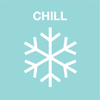 CHILL to keep foods at safe temperatures
CHILL to keep foods at safe temperatures

Acknowledgement: The CHILL icon opens to corresponding tips from a past FSIS.USDA BeFoodSafe campaign.
Excerpts from FSIS.USDA.gov How Temperatures Affect Food [9/24: Broken link changed to wsu copy of FSIS pdf.]
Properly handled food stored in a freezer at 0°F will be safe...In contrast to freezer storage, perishable foods will gradually spoil in the refrigerator. Spoilage bacteria will make themselves known in a variety of ways. The food may develop an uncharacteristic odor, color and/or become sticky or slimy. Molds may also grow and become visible.
Bacteria grow most rapidly in the range of temperatures between 40°F and 140°F, doubling in number in as little as 20 minutes. This range of temperatures is often called the "Danger Zone."
Because we know how different temperatures affect the growth of bacteria in our food, we can protect ourselves and our families from foodborne illnesses... by following safe food-handling practices.
Excerpts from FoodSafety.gov Chill: Refrigerate and Freeze Food Properly and various FSIS.USDA.gov Food Safety pages.
Beware the Danger Zone (40°F - 140°F)
- When Shopping:
- Purchase refrigerated or frozen items after selecting your nonperishables.
- Refrigerate perishable foods within 2 hours (1 hour when temperatures are above 90°F).
- If out longer, bring a cooler packed with plenty of ice, frozen gel packs or another cold source to keep perishables cold.
- When Preparing Food:
- Never thaw or marinate foods on the counter. The safest way to thaw or marinate meat, poultry, and seafood is in the refrigerator.
- When Traveling with Perishable Food (like sack lunch, party, picnic, camping):
- It is difficult to keep foods hot without a heat source when traveling, so it's best to cook foods before leaving home, cool them, transport them cold, then reheat them before eating.
- Use a cooler packed with plenty of ice, frozen gel packs or another cold source to keep perishables cold.
- Never leave perishable foods in the danger zone for more than 2 hours (1 hour for temperatures above 90°F).
- When Serving Cold Food:
- Cold food should be held at 40°F or colder.
- When serving food at a buffet, keep cold food cold by nesting dishes in bowls of ice or use small serving trays and replace them often.
- Use a food thermometer to check holding temperatures.
- Perishable food should not be left out more than 2 hours at room temperature (1 hour when the temperature is above 90°F).
- When Storing Food:
- Always refrigerate perishable food within 2 hours (1 hour when the temperature is above 90°F).
- Check the temperature of your refrigerator and freezer with an appliance thermometer. The refrigerator should be at 40°F or below and the freezer at 0°F or below.
- Cook or freeze fresh poultry, fish, ground meats, and variety meats within 2 days; other beef, veal, lamb, or pork, within 3 to 5 days.
- Freezing does not destroy harmful germs, but it does keep food safe until you can cook it.
- Leftovers should be placed in shallow containers and immediately put in the refrigerator or freezer for rapid cooling.
- Use most cooked leftovers within 3 to 4 days.
Know When to Throw Out Food:
- Discard any food left out at room temperature for more than 2 hours (1 hour if the temperature was above 90°F).
- Be sure you throw food out before harmful bacteria grow.
- Check Safe Storage Times chart.
